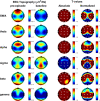EEG Activation Does Not Differ in Simple and Complex Episodes of Disorders of Arousal: A Spectral Analysis Study
- PMID: 35698590
- PMCID: PMC9188335
- DOI: 10.2147/NSS.S360120
EEG Activation Does Not Differ in Simple and Complex Episodes of Disorders of Arousal: A Spectral Analysis Study
Abstract
Purpose: Disorders of arousal (DoA) are characterized by incomplete awakening from NREM sleep, with the admixture of both deep sleep and wake EEG activity. Previous observations suggested that changes in EEG activity could be detected in the seconds preceding DoA episodes. The aims of this work were to characterize the topography of EEG spectral changes prior to DoA episodes and to investigate whether or not behavioral complexity could be predicted by changes in EEG immediately preceding behavioral onsets.
Patients and methods: We collected 103 consecutive video-polysomnographic recordings of 53 DoA adult patients and classified all episodes as simple, rising and complex arousal movements. For each episode, a 5-second window preceding its motor onset ("pre-event") and a 60-second window from 2 to 3 minutes before the episodes ("baseline") were compared. Subsequently, a between-group comparison was performed for the pre-event of simpler versus the more complex episodes.
Results: Spectral analysis over 325 DoA episodes showed an absolute significant increase prior to DoA episodes in all frequency bands excluding sigma, which displayed the opposite effect. In normalized maps, the increase was relatively higher over the central/anterior areas for both slow and fast frequency bands. No significant differences emerged from the comparison between simpler and more complex episodes.
Conclusion: Taken together, these results show that deep sleep and wake-like EEG rhythms coexist over overlapping areas before DoA episodes, suggesting an alteration of local sleep mechanisms. Episodes of different complexity are preceded by a similar EEG activation, implying that they possibly share a similar pathophysiology.
Keywords: disorders of arousal; neurophysiology; parasomnia; spectral EEG.
© 2022 Mainieri et al.
Conflict of interest statement
The authors report no conflicts of interest in this work.
Figures


References
-
- American Academy of Sleep Medicine. International Classification of Sleep Disorders. 3rd ed. Darien, IL: American Academy of Sleep Medicine; 2014. - PubMed
-
- Zucconi M, Oldani A, Ferini-Strambi L, Smirne S. Arousal fluctuations in non-rapid eye movement parasomnias: the role of cyclic alternating pattern as a measure of sleep instability. J Clin Neurophysiol off Publ Am Electroencephalogr Soc. 1995;12(2):147–154. - PubMed

